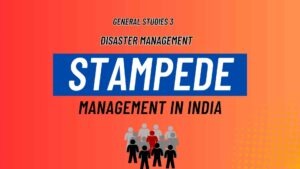Stampede Management in India- Important UPSC Notes
Stampede Management in India
🧠 What is a Stampede?
A stampede is a sudden and uncontrollable rush of a large group of people, often triggered by panic, fear, or excitement, especially in a crowded or confined space.
Such events can cause severe injuries or fatalities due to trampling, crushing, or suffocation.
Stampedes are often human-made disasters and are entirely preventable with proper planning and crowd management.
📰 Why in News?
On June 4, 2025, a stampede occurred at Chinnaswamy Stadium, Bengaluru, during RCB’s IPL victory parade.
Over 3 lakh people gathered at a venue with a capacity of just 35,000, leading to the death of 11 people and injuries to over 30.
The incident exposed severe lapses in crowd control, police deployment, and emergency preparedness.
🧾 Causes of Stampedes in India
Overcrowding
When the number of attendees exceeds the venue’s capacity.
Example: Bengaluru stadium hosted 3 lakh people in a venue built for 35,000.
Lack of Planning & Regulation
Absence of crowd-flow strategies, delayed security deployment.
Example: In Bengaluru, police arrived late despite anticipating large crowds.
Communication Failures
Misinformation, unclear announcements, or rumors can cause panic.
Example: Allahabad Railway Station stampede due to a last-minute platform change.
Infrastructure Deficiencies
Narrow entry/exit gates, poor signage, waterlogging, and barricades create choke points.
Example: Elphinstone Bridge (Mumbai) stampede due to waterlogging and no escape route.
No Emergency Protocols
Lack of trained personnel, medics, or standard operating procedures (SOPs) for emergencies.
⚠️ Impacts of Stampedes
Human Cost
Loss of lives and serious injuries, especially among vulnerable people like the elderly and children.
Public Distrust
Repeated crowd disasters erode trust in public events and state capacity to ensure safety.
Administrative Consequences
Inquiry commissions, blame games, suspensions, and resignations among officials.
Economic Losses
Compensation payments, event cancellations, and reduced tourist footfall.
Legal Consequences
PILs, lawsuits, and criminal negligence charges against organizers or authorities.
🧷 NDMA (National Disaster Management Authority) Guidelines on Crowd & Stampede Management
The NDMA is the apex body for disaster management in India. It has issued detailed guidelines to manage crowds safely:
Pre-Event Planning
Assess venue capacity, design crowd movement routes, and draft emergency response plans.
Access Control
Use barricades, ticketing systems, and check-points to regulate crowd inflow and outflow.
Trained Manpower
Deploy well-trained police, volunteers, and marshals for crowd guidance and response.
Communication Systems
Install clear multilingual signages, public address systems, and real-time announcements.
Emergency Preparedness
Ambulances, first-aid stations, and rehearsed evacuation drills must be in place.
Real-Time Monitoring
Use CCTV, drones, and sensors (e.g., heat maps) to track crowd density and movement.
💡 Solutions to Prevent Stampedes in the Future
Smart Technology for Crowd Monitoring
Use Artificial Intelligence (AI), thermal imaging, and drones for early detection of unsafe crowd behavior.
Decongesting Measures
Set up large screens outside venues, limit e-tickets, and schedule staggered entry times.
Strict Enforcement of Capacity Limits
Impose legal penalties for exceeding authorized crowd limits at events.
Mock Drills and Training
Regular simulation exercises for emergency teams to improve responsiveness and coordination.
Public Awareness Campaigns
Educate the public through social and print media on safe conduct during large gatherings.
🧭 Broader Relevance for UPSC
GS Paper II (Governance): Failure of public order management and emergency response systems.
GS Paper III (Disaster Management): Human-induced disasters; need for proactive disaster mitigation strategies.
GS Paper IV (Ethics): Responsibility and accountability of public officials; ethical concerns in crisis management.
✅ Conclusion
The Bengaluru stampede is a tragic reminder that celebrations must not compromise safety.
India must adopt a preventive, technology-enabled approach to managing large gatherings.
Accountability, preparedness, and public cooperation are the key pillars of safe mass events.
Mains-Based Questions on Stampede Management in India
Question 1:
Despite recurring incidents, crowd disasters such as stampedes continue to claim lives in India. Critically examine the systemic failures in managing large public gatherings and suggest reforms to address the issue. (250 words)
✅ Model Answer:
Introduction:
Stampedes are human-induced disasters resulting from uncontrolled crowd movements. Events like the 2025 Bengaluru stadium stampede and earlier ones at Elphinstone Bridge (Mumbai) and Allahabad Railway Station highlight recurring gaps in crowd management.
Body:
Systemic Failures:
Poor Planning: No pre-event risk assessment or crowd-flow modelling.
Inadequate Infrastructure: Narrow gates, blocked exits, lack of signage.
Delayed Emergency Response: Police often deployed reactively, not proactively.
Communication Gaps: Lack of real-time announcements or language-sensitive signage.
Lack of Trained Personnel: Volunteers and staff untrained in emergency evacuation.
Weak Legal Enforcement: Event organizers often flout capacity norms with impunity.
Reforms Needed:
Implement NDMA Guidelines Rigorously: Pre-event planning, surveillance, trained staff, emergency SOPs.
Technology Integration: Use of drones, AI-powered crowd monitoring, and heat maps.
Legal Accountability: Penal provisions for overcrowding and negligence.
Public Awareness Campaigns: Sensitizing citizens on safe behavior during large gatherings.
Capacity Building: Regular mock drills for police, marshals, and health workers.
Conclusion:
India must shift from reactive disaster response to preventive governance through legal, technological, and social reforms. Effective crowd management ensures both public safety and administrative legitimacy in a democracy.
Question 2:
“Most disasters in India are not acts of God, but failures of governance.” In the context of recurring stampedes, analyze this statement with examples. (150 words)
✅ Model Answer:
Introduction:
While natural disasters are often unpredictable, incidents like stampedes are preventable, making them largely failures of planning and governance.
Body:
Examples of Governance Failures:
Bengaluru (2025): 3 lakh people allowed in a 35,000-capacity stadium without adequate police deployment.
Elphinstone Bridge (2017): Lack of maintenance and evacuation space.
Allahabad (2013): Rumors and poor communication caused chaos.
Core Governance Issues:
Absence of risk assessment.
Lack of crowd control SOPs.
Weak enforcement of venue capacity limits.
No real-time communication or trained emergency staff.
Conclusion:
Stampedes demonstrate that disasters in India often stem from avoidable administrative lapses rather than external factors. Effective governance, guided by NDMA protocols and technological tools, can make mass gatherings safer.
Question 3:
Discuss the role of the National Disaster Management Authority (NDMA) in addressing non-natural disasters such as stampedes. Evaluate the effectiveness of its guidelines and suggest improvements. (250 words)
✅ Model Answer:
Introduction:
NDMA is the apex body in India for disaster management, established under the Disaster Management Act, 2005. While it is often associated with natural disasters, its role extends to managing human-induced disasters like stampedes.
Body:
Role of NDMA in Crowd Management:
Guidelines Issued for crowd management in religious gatherings, sports events, etc.
Emphasizes:
Pre-event risk assessment
Capacity calculation
Surveillance and monitoring
Emergency protocols and drills
Effectiveness:
Positive Aspects:
Provides a clear roadmap for event organizers and administrators.
Encourages use of technology (e.g., CCTV, drones).
Limitations:
Guidelines are advisory, not legally binding.
Implementation is inconsistent across states and events.
Lack of monitoring or penalty for non-compliance.
Suggestions for Improvement:
Make crowd management protocols mandatory through legislation.
Capacity building of local authorities via regular training.
Integrate AI and IoT for real-time crowd analysis.
Promote citizen engagement through awareness programs.
Conclusion:
NDMA plays a crucial role in shaping India’s disaster preparedness for crowd-related events. However, for true impact, its guidelines must be institutionalized and enforced effectively across all levels of governance.
-
Stampede Management in India – Important UPSC Notes
A stampede occurred at Chinnaswamy Stadium, Bengaluru, during RCB’s IPL... -
EnviStats India 2025 – Important UPSC Notes
The 8th edition of EnviStats India 2025 was released by... -
Quantum Computing – Important UPSC Notes
Tech giants like Google, IBM, and China’s Jiuzhang have developed... -
Indian Energy Security – Important UPSC Notes
In 2025, India became the 4th largest economy in the... -
Indian Food and Fertiliser Subsidies – Important UPSC Notes
With poverty down to 5.3%, distributing food subsidies to 800... -
India in SDR 2025 – Important UPSC Notes
India in SDR 2025 has ranked 99th, entering the Top... -
Indian FDI Mystery- Important UPSC Notes
India received a 13.7% increase in total FDI (Gross FDI...








